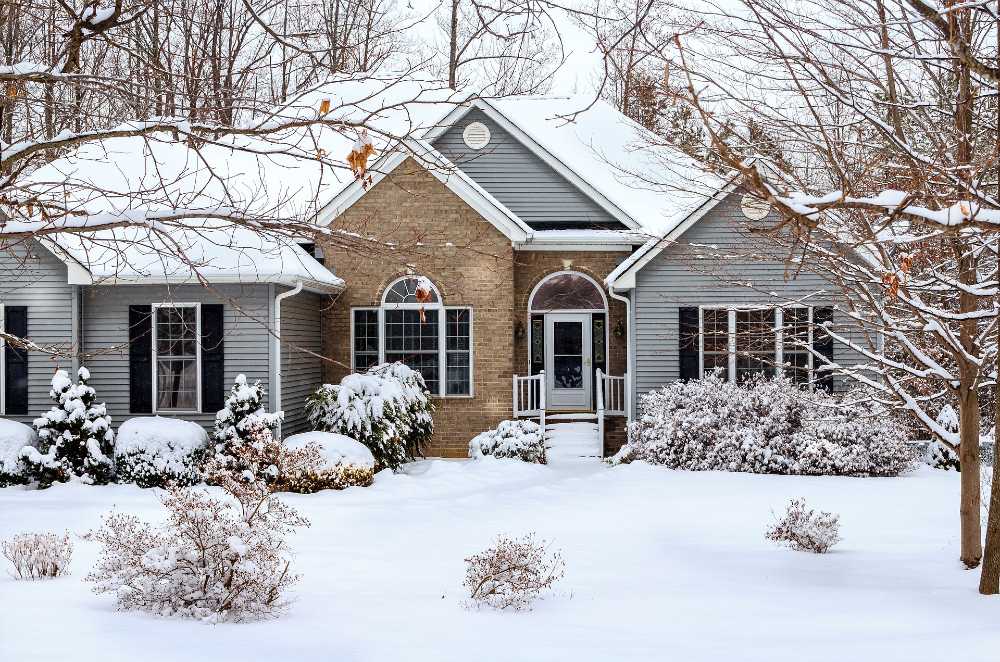Winter may seem like an unlikely time to worry about water damage, but snow is really just water in frozen form. Melting snow can enter your home through holes in your roof or siding as well as through cracks in your foundation. We look at the major types of snow storm damage and the cities most likely to be affected by heavy snowfalls.
Snowiest Cities Most Likely to Have Winter Storm Damage
These cities are most likely to face snow storm damage during winter storms due to the large amount of snowfall they get.
| City | Average Snowfall | Average January Temperature | |
| °F | °C | ||
| Syracuse, NY | 123.8 in | 23.6 | -4.7 |
| Flagstaff, AZ | 101.7 in | 29.9 | -1.2 |
| Erie, PA | 100.9 in | 27.3 | -2.6 |
| Rochester, NY | 99.5 in | 24.7 | -4.1 |
| Buffalo, NY | 94.7 in | 24.9 | -3.9 |
| Boulder, CO | 88.3 in | 34.6 | 1.4 |
| Duluth, MN | 86.1 in | 10.2 | -12.1 |
| Grand Rapids, MI | 74.9 in | 24.4 | -4.2 |
| Cleveland, OH | 68.1 in | 28.1 | -2.2 |
| South Bend, IN | 66.6 in | 24.5 | -4.2 |
| Worcester, MA | 64.1 in | 24.1 | -4.4 |
| Albany, NY | 59.1 in | 22.6 | -5.2 |
| Fargo, ND | 57.9 in | 9.3 | -12.6 |
| Ann Arbor, MI | 57.3 in | 24.6 | -4.1 |
| Provo, UT | 57.1 in | 31.0 | -0.6 |
| Lakewood, CO | 55.8 in | 33.6 | 0.9 |
| Billings, MT | 55 in | 27.1 | -2.7 |
| Manchester, NH | 54.9 in | 22.8 | -5.1 |
| Minneapolis, MN | 54.4 in | 15.6 | -9.1 |
| Denver, CO | 53.8 in | 31.0 | -0.6 |
Types of Snow Storm Damage
While you might not think of snow as a major cause of water or storm damage, it has the potential to cause significant damage to your home or business.
Leaks
Leaks are the most common type of snow storm damage. Whether during snowfalls or snowmelt, the water release from snow can leak into your home through any crack. The most common leaks are through the roof, but they can also enter from gutters, windows, and the seam along your foundation.
Snowmelt Flooding
In addition to leaks, melting snow can also cause significant floods. Although most common in Spring, melting snow can flood any time there is a rapid thaw after heavy snowfall. Snowmelt flooding can enter your home through foundation walls and basement or crawl space seams.
Ice Dams
Another type of snow storm damage are ice dams. Snow will build-up on your roof and repeatedly melt and freeze. In the liquid state, water will seep underneath shingles. As it freezes into ice, it will lift the shingles. Over time, water can work its way completely under your roof and eventually into your home.
Roof Damage
Snow build up on your roof can put a tremendous amount of stress on your home. Even light snowfalls will compact over time, putting pressure on your roofing shingles and decking. Older roofs are most susceptible to roof damage, as the weight of the snow breaks through into your home.
Burst Pipes
A burst pipe probably isn’t something you think of when it comes to snow storm damage. Whether the storm knocks out the power or temperatures fall due to a cold front, you have an increased chance of a burst pipe during snowier months. If the temperature stays below freezing for long enough, the water in the pipe may freeze and cause the pipe to burst.
Who to Call For Snow Storm Damage Cleanup and Restoration
If you have water damage as a result of snow storms, it’s important to remove the water as soon as possible. If you’re doing the work yourself, rent a submersible pump to extract the water as well as air movers and dehumidifiers to dry the damaged area.
If you don’t have the necessary time or equipment, the best option is to call a water damage restoration company. They have both the equipment and experience to extract water from snowstorms as well as dry out your home.
They will also disinfect and deodorize your home to prevent mold and odors from developing. As necessary, they will remove damaged materials and store the area just how you remember it.
The Winter Storm Damage Cleanup Process
Whether you choose to do the work yourself or hire a restoration contractor, the process of cleaning up snow storm damage is the same.
- Extract Standing Water – For deeper waters, use a submersible pump to remove water. Use a wet-dry shop-style vacuum for shallower water.
- Remove Damaged Materials – Water can damage many materials like drywall, carpeting, and cabinets. Remove items that cannot be saved.
- Dry the Structure – Dry drywall, carpeting, cabinets, and wall studs using air movers and dehumidifiers. Lift carpeting from the subfloor to speed drying.
- Disinfect and Deodorize – Apply disinfectants and deodorizers to damaged surfaces to prevent mold and odors.
- Rebuild the Area – If necessary, rebuild the flooded area. Typically this involved replacing carpeting, hanging new drywall, and installing new cabinets.
If you have winter storm damage from melting snow, we have water damage restoration specialists near you to repair the damage. Call 1-888-443-3110 for a free estimate on emergency water cleanup services.





